Punjab State Board PSEB 10th Class Physical Education Book Solutions Football Game Rules.
Football Game Rules – PSEB 10th Class Physical Education
Question 1.
Write a note on the FootBall playground, Goal Area, Goal, Penalty Area, Corner Area, Lines, and Ball?
Answer:
Football playground:
The football ground will be rectangular. Its Length is a Minimum of 90 M (100 yards), Maximum of 120 M (130 yards). Width Minimum 45 M (50 yards), Maximum 90 M (100 yards).
International Match. Length: Minimum 100 M (110 yards), Maximum 110 M (120 yards) Width: Minimum 64 M (70 yards), Maximum 90 M (100 yards).
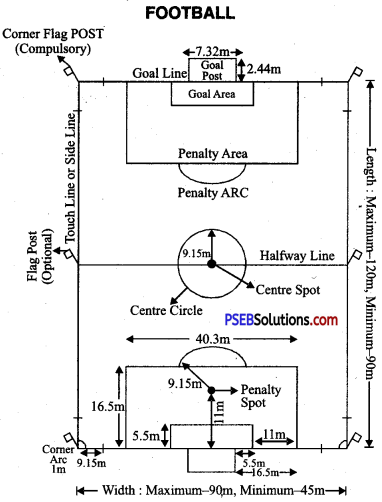
Marking:
The playfield should be marked with distinctive lines. These lines should not exceed five inches in width. Long lines are called touch lines and the short lines the goal lines. At each comer of the playfield a flag post is placed. Such a post should not be less than one yard outside the touch line. A circle shall be drawn in the centre of the field of play with a radius of ten yards.
Goal Area:
At each end of the playfield two lines shall be drawn which shall be at right angles to the goal lines. Each line shall extend upto 10 yards in the field, and shall be joined by a line drawn parallel to the goal line. The space encircled by these lines and the goal lines is called the goal area.
Penalty Area:
Two lines shall be drawn at each comer of the field at right angles to the goal lines. These lines shall be at a distance of 18 yards from each goal post, and shall be joined by a line drawn parallel to the goal line. The space enclosed by these lines and the goal lines is called a penalty area.
Goal Post:
Two posts shall be placed in the centre of goal lines at a distance of 8 yards or 24 feet. Their ends are joined by a crossbar. These are 8 high from the ground. The width and the thickness of goal posts and cross bars should not exceed 5″.
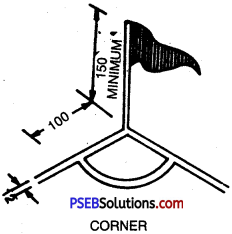
Corner Area:
From the post of each corner flag, a quarter circle, with a radius of one yard, will be drawn inside the playground. On all the four comers of the playfield 3 yard high flags are placed. Two flags are placed on either sides of the centre line outside the ground at a distance of 1 yard. The remaining flags are placed on the corner of the ground.
Ball:
The shape of football is spherical. Its upper part is made of leather or of some other approved material. Its circumference is not less than 68.5 cms and not more than 71 cms. Its weight shall be from 14 to 16 ounces. The ball cannot be changed during the play without the permission of the referee.
![]()
Question 2.
How many players take part in the game of Foot Ball? Describe the duration of the game, dress, numbers of officials, and goal?
Answer:
Number of players:
A football match is played between two teams. Each team consists of 11 players and 5 extra players. In a match no team is allowed to substitute more than two players. The substituted player is not allowed to take part in the match again.
Dress:
The player can normally wear a shirt or jersey, underpants (knickers), socks and shoes. The colour of the goalkeeper’s shirt or jersey shall be different from that of other players. The shoes are to be worn compulsorily.
Officials:
Among the officials are a referee and two line men. The referee makes the players obey the rules of the game and decides any matter of big dispute. His decision, about what happened in the game and what was the result, is final.
Duration of the Game:
The game is played in two equal durations of 45 minutfes each. An interval of 5 minutes follows the first duration, and of 10 minutes with the consent of the two teams. The start of play. In the beginning of the play the choice of the first kick and the side is made by a toss. The toss winning team is free to choose either side and to kick first.
Score or Goal:
When a ball, according to rules, crosses completely the goal line under the cross bar between the goal posts, a goal is allowed. The team scoring more goals shall be declared the winner. In case, no goal is scored or an equal number of goals are scored, the game shall be termed a draw. But if the tournament is taking place as per league rules, then in case of a draw both the teams shall be awarded 1 point each.
Golden Goal
If the football match ends in draw, the extra time for play will be given of which duration of play will be 15-15 minute each whenever during the period of a goal is scored by a team the match ends there and then. In case there is no result during the play, then 5-5 penalty strokes are made by each team till the winner is decided.
The Ball In and Out of play
The ball is out of play as a result of the following reasons:
- If the ball crosses the goal line on the ground or in the air.
- When the referee has stopped the game.
- When the ball goes out after having touched the goal post, cross bar or comer flag post.
- When the ball goes out of the goal line, in the goal posts under the crossbar, provided the ball is not thrown with hand or arm.
- When a player played the ball when the ball was at a lesser distance than him from the goal line of his rival.
The ball in the play
The ball remains in the play from the beginning to the end, but when it was in these situations:
- If the ball bounces back after having struck the goal post, the crossbar comer and flag.
- From a wrong play to the whistling of the umpire.
- When the ball strikes the umpire or line man when he is in the playfield.
- Till the sound of the whistle from outside the playfield.
- The game continues despite any infringement of a rule until the umpire stops the game.
Formation of Players:
The formation of players in football matches varies. Normally, it is 1-2-3-5. But in the European countries it is as follows:

The players continue to change the formation during the play according to the need.
![]()
Question 3.
What do you understand by off side, Free kick, Throw in, Penalty kick, Corner kick, Goal kick?
Answer:
(1) Off-side:
A player is off-side when he is in the half of his opponents or their goal line, and when there are no two opponents behind him. Even in such cases he is not off side if he is in the following situations:
- When he is in his own half of the field of play.
- When the ball last touches him or he plays with it.
- When he receives the ball from goal kick, throw-in or comer kick or he is thrown down by the referee.
- When the ball has been played by the opponent. For the violation of this rule, a free kick will be awarded to the players of the opposing team from the place of offence.
(2) Free Kick:
Free kick is of two types:
Direct kick and Indirect kick. When a player is taking a direct or indirect kick, opposing players should remain at a distance of 10 yards. The direct kick is that from which a goal can be scored direct. Indirect kick is that from which a goal cannot be scored unless the ball has been touched by any other player. In case of violation of this rule, the defensive team is awarded an indirect free kick from the spot of infringement.
(3) Throw-in:
When the ball passes over the touch line, either on the ground or in the air, it is thrown inside from the point where it has crossed the line. One player of the offending team throws the ball inside the playfield from the point where the ball has crossed the line.
The thrower at the time of delivering the ball must face the field. Either of his foot should be on or outside the touch line. The thrower will make use of both of his hands, and throw the ball from behind and over his head. He cannot play the ball until it has been touched or played by any other player.
If the throw-in is not proper, the opposing team takes the throw-in. If the thrower touches the ball before the ball has been touched or played by any other player, the opposing team is awarded a free indirect kick.
(4) Penalty Kick:
This kick is taken from the penalty mark. When it is being taken, only the player taking the kick and the opposing goalkeeper remain in the field of play. This mark will be at least 10 yards away. In order to complete the penalty kick the half time or the full time may be extended.
When a player is taking the penalty kick, the goalkeeper should remain standing at one place in the goal area. The goalkeeper can move after the kick has been taken. If such infringement takes place, the kick will be taken again. If, for some reason, the player taking the penalty kick misses it, then the defender is asked to take the kick from a distance of 16 yards.
If the defending team violates the rules and a goal has not been scored, the kick shall be taken again. In case of infringement of the rule by the opposing team, then the kick shall be taken again even though the goal has been Scored. If the infringement of the law is made by the player taking the kick, a player of the opposing team shall take a free hit on the place of infringement.
(5) Corner kick:
When the ball passes over the goal line and it has last been played by one of the players of the defending team, a member of the offending team is asked to take comer kick. The player of the opposing team takes the comer kick in a quarter area of the nearest flag post. Until the comer kick is taken, the players of the opposing team shall remain away at a distance of 10 yards. The kicker cannot touch the ball until it has been touched or played by another player.
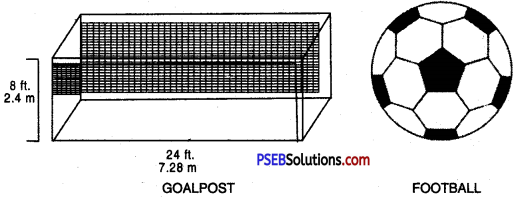
(6) Goal Kick:
When the ball passes over the goal line (not over the goal posts), and it is being played by the opposing team, then the defending team takes the kick outward the penalty area. When the kick is being taken, the players of the opposing team shall remain outside the penalty area. If the ball does not go out of the penalty area and does not reach the playground direct, the kick shall be re-taken. The kicker cannot touch it until it has been touched or played by another player.
![]()
Fouls and Offences in the Game of Football
(a) If a player intentionally commits the following offences or infringement of rules, the opposing team shall be awarded an indirect free kick from the place of infringement:
- Kicks or attempts to kick an opponent.
- Jumps, pushes or strikes a blow at an opponent.
- Charges an opponent in a violent or dangerous manner.
- Charges an opponent from behind.
- Holds an opponent or plays by holding on to his clothes.
- Hurts or attempts to hurt an opponent.
- Obstructs an opponent or throws him by the use of his legs or attempts to throw him.
- Pushes an opponent with his hand or any part of his arm.
- Holds the ball in his hand.
If a player of the defending team commits any of these offences in the penalty area, the attacking team is given penalty kick.
(b) If a player, commits the following offences, the opposing team shall be awarded an indirect free kick from the place of infringement:
- When he plays the ball in dangerous way.
- When the ball is away and he charges the other player with shoulder.
- While playing, he deliberately obstructs the player of the opposing team.
- To attack the goalkeeper, except:
-
- When he is obstructing an opponent.
- When he is holding the ball.
- When the ball goes out of his goal area.
5. (a) When as a goalkeeper, he takes more than four steps without throwing the ball on the ground.
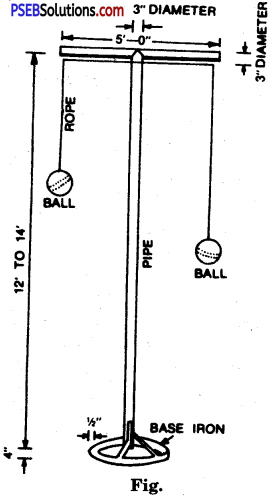
(b) When as a goalkeeper he indulges in such tactics as hold up a game and waste the time, and tries to give undue advantage to his team.
(c) A player shall be warned that the opposing team shall be awarded an indirect free kick if:
- he indulges in abuses and plays foul.
- he misbehaves even on being warned.
- he plays foul or misbehaves. In that case, the referee can send him off the field for the whole duration of the game.
![]()
Question 4.
Describe some important Technique of Football?
Answer:
The important Technique of Football
Kicking:
Kicking is a way of moving the ball towards the required direction with the help of feet, with the required speed keeping in view that the ball reaches its destination. In the art of kicking, accuracy, speed, direction and distance are maintained not by left or right foot but by both feet.
The most important point in the training of the players is about the need of playing the game with both feet. It is easy to teach the young new players how to play with both feet. Without it, it is difficult for a player to reach any level of success in the game.
- To kick with the inside of feet.
- To kick with the outside of feet.
When the ball is kicked within a short distance these two variations are put into use. The ball moves slowly but a great improvement is brought about, as result of which this method is often put into use at the time of aiming towards the goals.
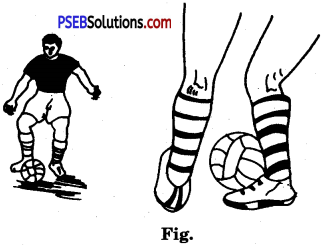
Half Kick:
When the ball comes bouncing to the player or is in the air, there is then a sort of instability not only about its direction of bouncing because of the level of football ground but also about its height and speed. The most effective way of making it clear is the right time, co-ordination of the movements of kicking feet and the raising of the ball upto a proper height.
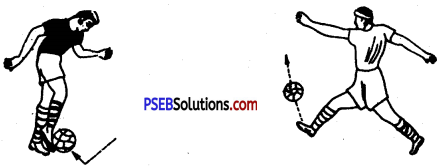
Over head kick:
This kick is taken with a three-fold purpose
(a) to deflect the ball from the opposing player
(b) to move the ball towards the direction of the kick, and
(c) to turn the ball back towards the direction from where it came. Over-head kick is an improved form of kick, and is generally taken in case the ball is bouncing.
To Make Pass:
The action of making ‘passes’ in football is the basis of team work. The pass increases the co-ordination among the team and adds to the growth of team work. Connected with the condition of the play a ‘pass’ is an evidence of the team play and hence is a basic element for which special time and attention should be given during the training and practice of the team. To achieve perfection at goals a team pass is a right type of kick by an individual player.
It is said that a successful pass is better than kicks. To give pass is an important part of inter-relatedness. It is to harmonize the complex structure of mutual movement between players with individual intelligence at the time of attack and defence during the play. In giving pass, one who makes ‘pass’ the ball and the one who receives the ‘pass’ are involved.
Making passes are normally categorised into long and short passes:
(a) Long passes:
These passes are made use of when there is rapid movement in the game. In such situations long passes prove to be very useful. In such passes, the ball can be moved both sideways and backward. In all long passes, the upper part of the foot or kick is used. The long passes strengthen the defence and facilitate short passes.
(b) Short passes:
Short passes are used for a distance of 15 yards or so, and they are more quick and accurate than long passes.
Push pass:
The use of push pass is made when the opponent is not very near. It is also made to throw the ball in the goal area at a close distance and to throw the ball towards the sides.
Low-pass:
It is shorter than push-pass. In it, the ball is raised high and bounced. It is used to cross the ball over the head of the opponent when he is quite near or is trying to take the throw-ball.
![]()
The Outer-parts of Feet-Flick or Jab Pass
In contrast to the other two passes, the flick pass is used to flick or push the ball, having turned the feet inward. This type of pass is used to give pass towards the back while keeping the ball in possession and dribbling it.
Trapping:
Trapping is the basis of controlling the ball. The trapping of the ball means preventing the ball from going away from the player. It is not merely an activity of stopping the ball or making it stationary but also an essential technique used to take the ball in firm hold. Stopping the ball is first step of ball control, and the second part which the player brings into practice for his own benefit is also essential.
Note:
The training of traps should be given for
(a) dribbling ball and
(b) bouncing ball.

Trap with the Under-foot:
Such a type of trapping is good if you have no hurry and enough freedom, and nobody is beside you.
![]()
Trap with Inner Parts of Feet
It is most effective and commonly used trap. Not only does this trap enable a player to trap the ball but also helps him in moving towards any direction. This trap is particularly good for the ball coming from a side or a comer. If the ball comes straight, the body is moved in the direction in which the ball is to go.

Trap with the Outer Part of Foot
It is like the earlier one but it is difficult for in it one has to keep the balance as the weight of the player’s body turns outside and off the centre.
Pet or Chest-trap
When the ball is above the waist and cannot be effectively trapped with feet, it is taken on the abdomen or chest or as it bounces from the ground.

Head-trap
It is meant for those experienced players who are well-versed in the foundation of ‘heading’.
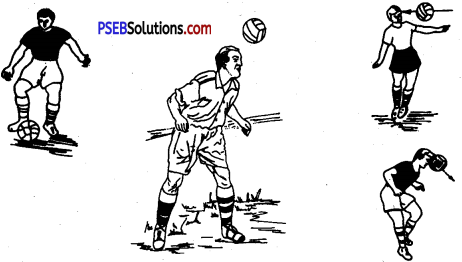
![]()
Important Information About the Football Game
- The length of the ground = 100 yards to 130 yards 100 metre to 120 metre
- The Breadth of the ground = 50 yards to 100 yards 45 meter to 90 metre
- The shape of football ground = square
- Number of players in one team = 11 and 5 substitutes
- Circumference of the ball = 27° to 28°
- Weight of the ball = 14 Aunce to 18 aunce
- Duration of the match = 45-45 minutes of two half
- Interval time = 15 minutes
- Substitution of players in one match = 3 players
- Official of the match = One table official, one referee, two line man,
- Height of the goal post = 2.44 m
- Height of the corner flag = 5
- The match is played between two teams. Each team has eleven players. The total number of players in a team are 16, out of which only 11 play. Among these players there is a goalkeeper. 5 players are kept in reserve as substitutes.
- During the play a team cannot substitute more than two players. A substituted player is not allowed to play again.
- The duration of the game will be 45-5-45 minutes. The interval will be of 5 minutes.
- After the interval the teams change their ends/sides.
- By giving pass to each other on the fixed spot on the centre, line, that players start the game. Ends are decided by toss.
- One table official, a referee and two line men are officials for the match.
- The dress of the goalkeeper is different from that of his team.
- The player should not wear anything which may prove to be dangerous to other players.
- The game stops when the ball crosses the goal or side line.
- The referee can ask for the stoppage of the game for some reason.
